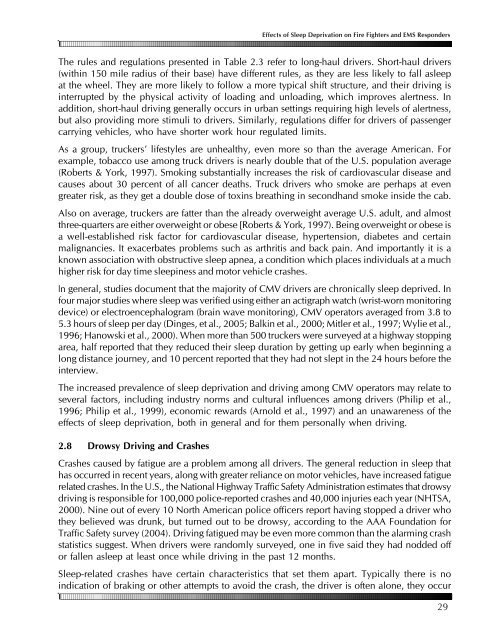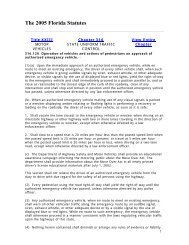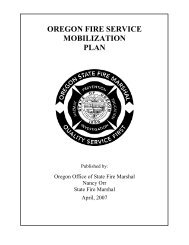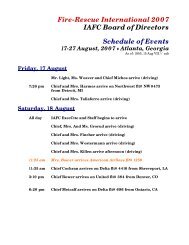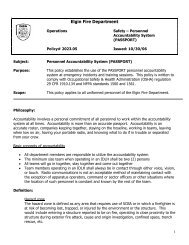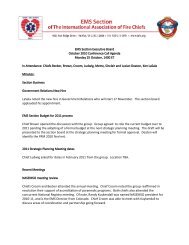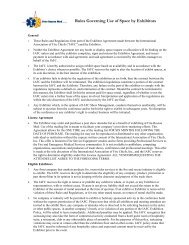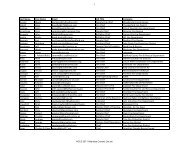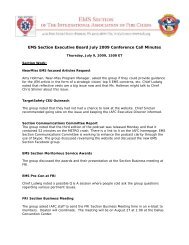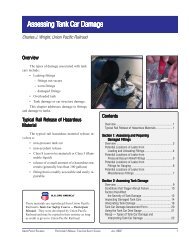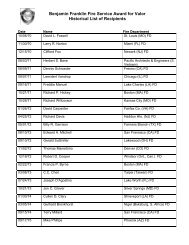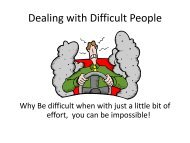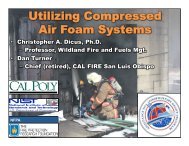Effects of Sleep Deprivation on Fire Fighters and EMS ... - NAEMT
Effects of Sleep Deprivation on Fire Fighters and EMS ... - NAEMT
Effects of Sleep Deprivation on Fire Fighters and EMS ... - NAEMT
You also want an ePaper? Increase the reach of your titles
YUMPU automatically turns print PDFs into web optimized ePapers that Google loves.
<str<strong>on</strong>g>Effects</str<strong>on</strong>g> <str<strong>on</strong>g>of</str<strong>on</strong>g> <str<strong>on</strong>g>Sleep</str<strong>on</strong>g> <str<strong>on</strong>g>Deprivati<strong>on</strong></str<strong>on</strong>g> <strong>on</strong> <strong>Fire</strong> <strong>Fighters</strong> <strong>and</strong> <strong>EMS</strong> Resp<strong>on</strong>ders<br />
The rules <strong>and</strong> regulati<strong>on</strong>s presented in Table 2.3 refer to l<strong>on</strong>g-haul drivers. Short-haul drivers<br />
(within 150 mile radius <str<strong>on</strong>g>of</str<strong>on</strong>g> their base) have different rules, as they are less likely to fall asleep<br />
at the wheel. They are more likely to follow a more typical shift structure, <strong>and</strong> their driving is<br />
interrupted by the physical activity <str<strong>on</strong>g>of</str<strong>on</strong>g> loading <strong>and</strong> unloading, which improves alertness. In<br />
additi<strong>on</strong>, short-haul driving generally occurs in urban settings requiring high levels <str<strong>on</strong>g>of</str<strong>on</strong>g> alertness,<br />
but also providing more stimuli to drivers. Similarly, regulati<strong>on</strong>s differ for drivers <str<strong>on</strong>g>of</str<strong>on</strong>g> passenger<br />
carrying vehicles, who have shorter work hour regulated limits.<br />
As a group, truckers’ lifestyles are unhealthy, even more so than the average American. For<br />
example, tobacco use am<strong>on</strong>g truck drivers is nearly double that <str<strong>on</strong>g>of</str<strong>on</strong>g> the U.S. populati<strong>on</strong> average<br />
(Roberts & York, 1997). Smoking substantially increases the risk <str<strong>on</strong>g>of</str<strong>on</strong>g> cardiovascular disease <strong>and</strong><br />
causes about 30 percent <str<strong>on</strong>g>of</str<strong>on</strong>g> all cancer deaths. Truck drivers who smoke are perhaps at even<br />
greater risk, as they get a double dose <str<strong>on</strong>g>of</str<strong>on</strong>g> toxins breathing in sec<strong>on</strong>dh<strong>and</strong> smoke inside the cab.<br />
Also <strong>on</strong> average, truckers are fatter than the already overweight average U.S. adult, <strong>and</strong> almost<br />
three-quarters are either overweight or obese [Roberts & York, 1997). Being overweight or obese is<br />
a well-established risk factor for cardiovascular disease, hypertensi<strong>on</strong>, diabetes <strong>and</strong> certain<br />
malignancies. It exacerbates problems such as arthritis <strong>and</strong> back pain. And importantly it is a<br />
known associati<strong>on</strong> with obstructive sleep apnea, a c<strong>on</strong>diti<strong>on</strong> which places individuals at a much<br />
higher risk for day time sleepiness <strong>and</strong> motor vehicle crashes.<br />
In general, studies document that the majority <str<strong>on</strong>g>of</str<strong>on</strong>g> CMV drivers are chr<strong>on</strong>ically sleep deprived. In<br />
four major studies where sleep was verified using either an actigraph watch (wrist-worn m<strong>on</strong>itoring<br />
device) or electroencephalogram (brain wave m<strong>on</strong>itoring), CMV operators averaged from 3.8 to<br />
5.3 hours <str<strong>on</strong>g>of</str<strong>on</strong>g> sleep per day (Dinges, et al., 2005; Balkin et al., 2000; Mitler et al., 1997; Wylie et al.,<br />
1996; Hanowski et al., 2000). When more than 500 truckers were surveyed at a highway stopping<br />
area, half reported that they reduced their sleep durati<strong>on</strong> by getting up early when beginning a<br />
l<strong>on</strong>g distance journey, <strong>and</strong> 10 percent reported that they had not slept in the 24 hours before the<br />
interview.<br />
The increased prevalence <str<strong>on</strong>g>of</str<strong>on</strong>g> sleep deprivati<strong>on</strong> <strong>and</strong> driving am<strong>on</strong>g CMV operators may relate to<br />
several factors, including industry norms <strong>and</strong> cultural influences am<strong>on</strong>g drivers (Philip et al.,<br />
1996; Philip et al., 1999), ec<strong>on</strong>omic rewards (Arnold et al., 1997) <strong>and</strong> an unawareness <str<strong>on</strong>g>of</str<strong>on</strong>g> the<br />
effects <str<strong>on</strong>g>of</str<strong>on</strong>g> sleep deprivati<strong>on</strong>, both in general <strong>and</strong> for them pers<strong>on</strong>ally when driving.<br />
2.8 Drowsy Driving <strong>and</strong> Crashes<br />
Crashes caused by fatigue are a problem am<strong>on</strong>g all drivers. The general reducti<strong>on</strong> in sleep that<br />
has occurred in recent years, al<strong>on</strong>g with greater reliance <strong>on</strong> motor vehicles, have increased fatigue<br />
related crashes. In the U.S., the Nati<strong>on</strong>al Highway Traffic Safety Administrati<strong>on</strong> estimates that drowsy<br />
driving is resp<strong>on</strong>sible for 100,000 police-reported crashes <strong>and</strong> 40,000 injuries each year (NHTSA,<br />
2000). Nine out <str<strong>on</strong>g>of</str<strong>on</strong>g> every 10 North American police <str<strong>on</strong>g>of</str<strong>on</strong>g>ficers report having stopped a driver who<br />
they believed was drunk, but turned out to be drowsy, according to the AAA Foundati<strong>on</strong> for<br />
Traffic Safety survey (2004). Driving fatigued may be even more comm<strong>on</strong> than the alarming crash<br />
statistics suggest. When drivers were r<strong>and</strong>omly surveyed, <strong>on</strong>e in five said they had nodded <str<strong>on</strong>g>of</str<strong>on</strong>g>f<br />
or fallen asleep at least <strong>on</strong>ce while driving in the past 12 m<strong>on</strong>ths.<br />
<str<strong>on</strong>g>Sleep</str<strong>on</strong>g>-related crashes have certain characteristics that set them apart. Typically there is no<br />
indicati<strong>on</strong> <str<strong>on</strong>g>of</str<strong>on</strong>g> braking or other attempts to avoid the crash, the driver is <str<strong>on</strong>g>of</str<strong>on</strong>g>ten al<strong>on</strong>e, they occur<br />
29


